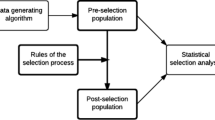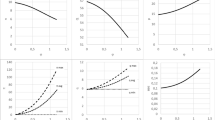Abstract
This paper studies the influence of sunk costs on industry evolution using the stylized pure selection model developed by Metcalfe. It is shown that sunk costs influence industry dynamics by reducing the speed of the replicator dynamics of competitive selection. Based on the theoretical model, we argue that sunk costs should lead to a reduction of market share reallocation dynamics and a larger share of stable firms. We validate these predictions empirically, finding that higher-sunk-cost industries have a larger share of stable firms and display lower market share dynamics. The result has practical implications for the interpretation of productivity decompositions.


Similar content being viewed by others
Notes
The applicability and relevance of replicator dynamics to model industry evolution has been addressed extensively in the literature (e.g. Nelson and Winter 1982, Silverberg et al. 1988, Dosi 2007). The contribution of Metcalfe has been widely cited. Google Scholar (retrieved on October 2, 2014) reports 944 citations of the 1998 book Evolutionary Economics and Creative Destruction for the period 1998 to 2014.
If \(\delta =\infty \) in Eq. (3) even infintesimal small deviations from the average price \(\bar {p}_{v}\) lead to large changes in customer demand. Firms will not deviate from this price.
In Appendix B we detail additional results using the three-digit level for the firm growth rate distribution regressions. We decided to present the two-digit level results in the paper because (i) it was not possible to obtain an indicator for capital intensity at the three-digit level for Austrian industries, (ii) the number of firms in some three-digit industries is very small and (iii) because we could not find any data at the three-digit level for productivity decompositions.
The evolutionary literature on technological regimes argues that firm-specific assets are embedded in the cross-sectional differences of the sources of knowledge that produce innovation (e.g. Winter 1984). A number of contributions have shown that industry-specific characteristics play a fundamental role in explaining the evolution of specific industries (e.g. Audretsch 1991, Malerba and Orsenigo 1995, Breschi et al. 2000).
In this dataset it is not entirely clear whether the business units are enterprises or establishments. It is left to the discretion of the individual firm whether it chooses to report at the enterprise or establishment level. (Stiglbauer 2003) argues that the majority of the data are found at the level of the enterprise, since firms reduce their administrative burdens when reporting social security contributions. See Hofer and Winter-Ebmer (2003) and Hölzl (2014) for more details on this data.
The use of a symmetric interval of growth rates may seem odd, however, it needs to be taken into account that the growth rates in the theoretical are measured in terms of output, here we measure growth in employment terms. Most of the manufacturing industries display quite substantial productivity growth, thus negative employment growth can go hand in hand with a stagnation in output. The same definition of stable firms is also used by Criscuolo et al. (2013).
Firm-level studies provide a confirmation of this finding. They show that profit rates and productivity are quite heterogeneous across firms and display a high degree of persistence, while firm growth rates are not persistent over time and display almost no relation to profits or productivity levels (see Dosi (2007) or Coad and Hölzl (2012) for surveys)
See Appendix C for more details on this decomposition.
However, sunk cots cannot explain why the reallocation term is sometimes negative. This may be related to the measurement of contributions to productivity growth. Nishida et al. (2014) suggest that defining aggregate productivity growth and its decompositions in terms of its impact on final demand eliminates negative reallocation effects.
References
Asplund M (2000) What fraction of a capital investment is sunk costs. J Ind Econ 48(3):287–304
Audretsch DB (1991) New firm survival and the technological regime. Rev Econ Stat 73(3):441–450
Baily M, Bartelsman EJ, Haltiwanger JC (1996) Downsizing and productivity growth: myth or reality?. Small Bus Econ 8(4):259–278
Bartelsman E, Haltiwanger J, Scarpetta S (2004) Microeconomic evidence of creative destruction in industrial and developing countries. Tinbergen Institute Discussion Papers 04-114/3, Tinbergen Institute.
Bottazzi G, Dosi G , Jacoby N, Secchi A, Tamagni F (2010) Corporate performances and market selection. Some comparative evidence. Ind Corp Chang 19:1953–1996
Bravo-Biosca A, Criscuolo C, Menon C (2013) What drives the dynamics of business growth? OECD Science, Technology and Industry Policy Papers, No. 1, OECD Publishing.
Breschi S, Malerba F, Orsenigo L (2000) Technological regimes and schumpeterian patterns of innovation. Econ J 110:388–410
Cabral L (1995) Sunk costs, firm size and firm growth. J Ind Econ 43(2):161–172
Cantner U (2002) Heterogenit?t, technologischer fortschritt und spillover-effekte. In: Lehmann-Waffenschmidt M (ed) Studien zur Evolutorischen ? konomik V. Duncker & Humblodt, Berlin , pp 15–40
Caves RE, Porter ME (1977) From entry barriers to mobility barriers. Q J Econ 91:241–261
Coad A (2007) Testing the principle of ‘growth of the fitter’: the relationship between profits and firm growth. Struct Chang Econ Dyn 18(3):370–386
Coad A, Hölzl W (2012) ‘Firm growth: empirical analysis’. In: Dietrich M, Krafft J (eds) Handbook on the economics and theory of the firm. Edward Elgar, Cheltenham
Disney R, Haskel J, Heden Y (2003) Restructuring and productivity growth in UK manufacturing. Econ J 113:666–694
Dixit A (1989) Entry and exit decisions under uncertainty. J Polit Econ 97:620–638
Dosi G (2007) Statistical regularities in the evolution of industries: a guide through some evidence and challenges for the theory. In: Malerba F, Brusoni S (eds) Perspectives on Innovation. Cambridge University Press, Cambridge
Eaton BC, Lipsey RG (1980) Exit barriers are entry barriers: the durability of captial as barrier to entry. Bell J Econ 11:721–729
Farinas JC, Ruano S (2005) Firm productivity, heterogeneity, sunk costs and market selection. Int J Ind Organ 23:505–534
Gschwandtner A, Lambson VE (2012) Sunk costs, depreciation, and industry dynamics. Rev Econ Stat 94:1059–1065
Foster L, Haltiwanger J, Krizan CJ (1998) Aggregate productivity growth: lessons from microeconomic evidence. NBER working paper 6803.
Garnsey E, Stam E, Heffernan P (2006) New firm growth: exploring processes and paths. Ind Innov 13(1):1–20
Griliches Z, Regev H (1995) Firm productivity in Israeli industry 1979-1988. J Econom 65(1):175–203
Hofer H, Winter-Ebmer R (2003) Longitudinal data from social security records in Austria. Schmollers Jahrbuch 123:587–591
Hölzl W, Lang P (2011) Unternehmensdynamik, exportstatus und umsatzproduktivität. WIFO Monatsberichte 84(11):743–754
Hölzl W (2014) Persistence, survival, and growth: a closer look at 20 years of fast-growing firms in Austria. Ind Corp Chang 23:199–231
Isaksson A (2009) Structural change and productivity growth: A review with implications for developing countries. Research and statistics branch working paper 08/2009, UNIDO, Vienna
Klemperer (1995) Competition when consumers have switching costs: an overview with applications to industrial organization, macroeconomics, and international trade. Rev Econ Stud 62:515–539
Krafft J, Salies E (2008) The cost of switching internet providers in the broadband industry, or why ADSL has diffused faster than other innovative technologies: evidence from the French case. Res Policy 37:706–719
Lambson V, Jensen F (1998) Sunk costs and firm value variability: theory and evidence. Am Econ Rev 88:307–313
Malerba F, Orsenigo L (1995) Schumpeterian patterns of innovation. Camb J Econ 19:47–65
Melitz M, Polanec S (2009) Dynamic olley-pakes decomposition with entry and exit. Discussion paper, University of Lubljana Working Paper no. 03/09, forthcoming RAND J Econ
Metcalfe JS (1994) Competition, Fisher’s principle and increasing returns in the selection process. J Evol Econ 4:327–346
Metcalfe JS (1998) Evolutionary economics. Routledge, London
Metcalfe JS (2002) On the optimality of the competitive process: Kimura’s theorem and MarketDynamics. J Bioecon 4:2109–133
Mueller DC, Supina D (2002) Goodwill capital. Small Bus Econ 19:233–253
Nelson RR, Winter SG (1982) An evolutionary theory of economic change. Belknap Press of Harvard University Press, Cambridge
Nishida M, Petrin A, Polanec S (2014) Explaining reallocation’s apparent negative contribution to growth. J Product Anal 42:187–210
Olley G, Pakes A (1996) The dynamics of productivity in the telecommunications equipment industry. Econometrica 64(6):1263–1297
Pages C, Pierre G, Scarpetta S (2009) Job creation in Latin America and the Carribbean: recent trends and policy challenges. Macmillan, London
Papke L, Wooldridge J (1996) Econometric methods for fractional response variables with an application to 401(k) plan participation rates. J Appl Econom 11:619–632
Ramey V, Shapiro M (2001) Displaced capital. A study of aerospace plant closings. J Polit Econ 109: 958–92
Santarelli E, Vivarelli M (2007) Entrepreneurship and the process of firms’ entry, survival and growth. Ind Corp Chang 16(3):455–488
Silverberg G, Dosi G, Orsenigo L (1988) Innovation, diversity and diffusion: a self-organization model. Econ J 98:1032–1054
Stiglbauer A (2003) Job and worker flows in Austria 1978-1998. Ph.D. thesis, University of Linz
Sutton J (1998) Technology and market structure. MIT Press, Cambridge MA
Winter SG (1984) Schumpeterian competition in alternative technological regimes. J Econ Behav Organ 5:287–320
Author information
Authors and Affiliations
Corresponding author
Appendices
Appendix A: Derivation of the pricing rule of dynamic firms
The overall average price at the population level is defined as
This expression accounts for the different pricing behaviors in the three subpopulations. By inserting the expressions of the average prices in the marginal and dynamic groups follows:
\(\bar {p}_{d}\) is obtained by aggregating the price equation for dynamic firms:
where \(\bar {c}_{d}={\sum }_{i} d_{i} c_{i}\). By eliminating the average price from the pricing equation a dynamic firm and re-arranging we obtain Eq. 5 in the text.
Appendix B: Regressions using NACE three-digit
Appendix C: The dynamic Olley-Pakes decompositon
Melitz and Polanec (2009) argue that all productivity decomposition methods used in the literature - the Foster et al. (1998) decomposition and the Griliches and Regev (1995) decomposition - do not allow to identify the different channels of productivity improvement in a correct way. They suggest a different decomposition that avoids fixed weights in the division of the contribution of surviving firms and eliminates the bias towards within-firm productivity improvements. Melitz and Polanec (2009) propose the use of a dynamic decomposition that is based on the static decompositon proposed by Olley and Pakes (1996). The change in aggregate productivity P between time t and time t+Δt is decomposed in the following way:
where \({\Delta } \bar {p}_{S}\) is the difference in the unweighted productivities of surviving firms and captures the within-firm productivity improvement, and Δc o v S is the difference of the covariances of market share and productivity multiplied by the number of firms between t and t+Δt. This captures the contribution of reallocation. \(s_{E,t+{\Delta } t}\left (P_{E,t+{\Delta } t}- P_{S,t+{\Delta } t}\right )\) is the contribution of entry measured as the difference of the productivities between entrants and surviving firms at time t+Δt. \(s_{X,t}\left (P_{S,t}-P_{X,t}\right )\) is the contribution of exit measured as the difference between surviving firms and exits at time t. For Slovenian manufacturing, Melitz and Polanec (2009) show that their decomposition leads to a consistently higher contribution of reallocation to productivity growth than other decomposition methods but that the within-firm productivity improvements still dominate the productivity terms. For Austria similar evidence is provided by Hölzl and Lang (2011).
Rights and permissions
About this article
Cite this article
Hölzl, W. Sunk costs and the speed of market selection. J Evol Econ 25, 323–344 (2015). https://doi.org/10.1007/s00191-014-0389-x
Published:
Issue Date:
DOI: https://doi.org/10.1007/s00191-014-0389-x




